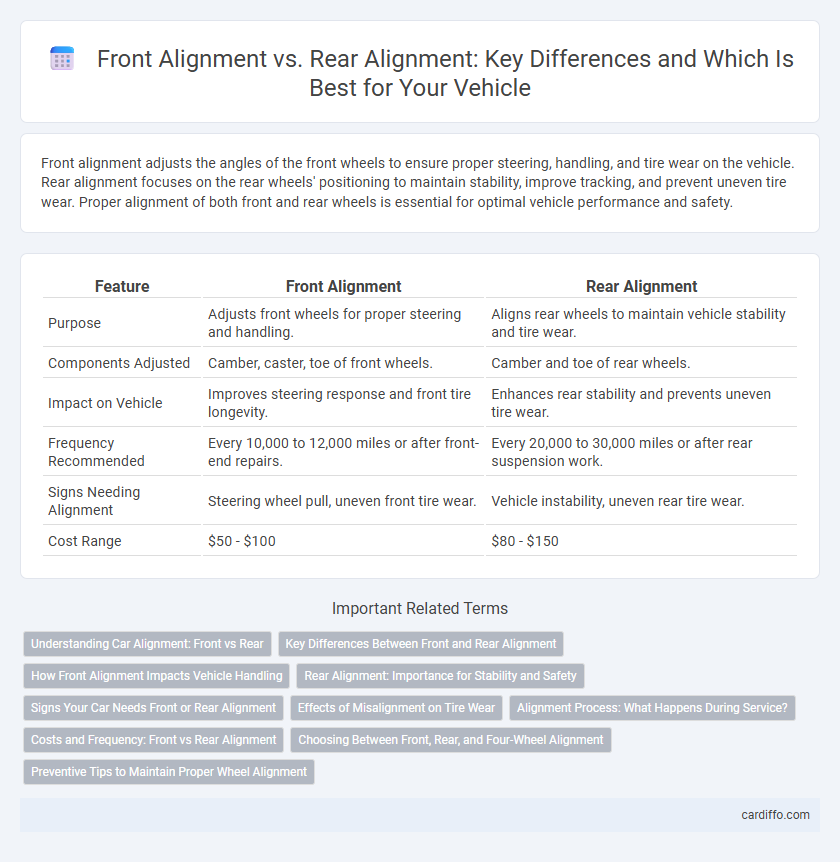Front alignment adjusts the angles of the front wheels to ensure proper steering, handling, and tire wear on the vehicle. Rear alignment focuses on the rear wheels' positioning to maintain stability, improve tracking, and prevent uneven tire wear. Proper alignment of both front and rear wheels is essential for optimal vehicle performance and safety.
Table of Comparison
| Feature | Front Alignment | Rear Alignment |
|---|---|---|
| Purpose | Adjusts front wheels for proper steering and handling. | Aligns rear wheels to maintain vehicle stability and tire wear. |
| Components Adjusted | Camber, caster, toe of front wheels. | Camber and toe of rear wheels. |
| Impact on Vehicle | Improves steering response and front tire longevity. | Enhances rear stability and prevents uneven tire wear. |
| Frequency Recommended | Every 10,000 to 12,000 miles or after front-end repairs. | Every 20,000 to 30,000 miles or after rear suspension work. |
| Signs Needing Alignment | Steering wheel pull, uneven front tire wear. | Vehicle instability, uneven rear tire wear. |
| Cost Range | $50 - $100 | $80 - $150 |
Understanding Car Alignment: Front vs Rear
Front alignment primarily adjusts the angle of the front wheels, influencing steering control, tire wear, and vehicle handling, while rear alignment focuses on the rear wheels to enhance stability and tracking precision. Correct front alignment settings include camber, caster, and toe angles to optimize directional response and tire contact with the road. Rear alignment adjustments ensure consistent tire wear and balance by maintaining proper toe settings and, in some cases, camber, particularly in vehicles with independent rear suspension systems.
Key Differences Between Front and Rear Alignment
Front alignment focuses on adjusting the camber, caster, and toe angles of the front wheels to ensure optimal steering response, tire wear, and vehicle handling. Rear alignment primarily addresses toe and camber settings to maintain vehicle stability, straight-line tracking, and proper tire contact with the road. Key differences include the front alignment's impact on steering precision and the rear alignment's role in directional stability and tire longevity.
How Front Alignment Impacts Vehicle Handling
Front alignment directly affects steering responsiveness and vehicle stability, ensuring precise control during turns and preventing uneven tire wear. Misalignment in the front can cause pulling to one side, vibrations, and increased steering effort, which compromises safety and driving comfort. Proper front alignment optimizes tire contact with the road, enhancing traction and overall handling performance.
Rear Alignment: Importance for Stability and Safety
Rear alignment plays a crucial role in vehicle stability and safety by ensuring the rear wheels are properly adjusted to maintain optimal contact with the road. Proper rear alignment prevents issues such as oversteering or fishtailing, which can compromise handling, especially during high-speed driving or emergency maneuvers. Accurate rear alignment also reduces uneven tire wear, improving overall vehicle performance and extending tire lifespan.
Signs Your Car Needs Front or Rear Alignment
Uneven tire wear on the front tires often signals the need for front alignment, affecting steering precision and vehicle stability. Pulling to one side while driving or a crooked steering wheel indicates misalignment in either front or rear wheels but is more commonly linked to front alignment issues. Rear alignment problems typically manifest as shaking or wobbling at high speeds, compromising overall handling and safety.
Effects of Misalignment on Tire Wear
Misalignment in front alignment primarily causes uneven tire wear on the inner or outer edges, leading to reduced tire lifespan and compromised handling. Rear alignment issues often result in rapid tread wear and instability, affecting overall vehicle balance and safety. Proper alignment ensures even tire contact with the road, enhancing tire durability and driving performance.
Alignment Process: What Happens During Service?
During front alignment, technicians adjust the camber, caster, and toe angles of the front wheels to ensure proper steering response and tire wear. Rear alignment involves correcting the rear wheel angles, primarily the camber and toe, to improve vehicle stability and handling. Both processes use specialized alignment machines with precise sensors to measure wheel positions and guide accurate adjustments.
Costs and Frequency: Front vs Rear Alignment
Front alignment typically costs less than rear alignment due to the simpler adjustments involved in steering components. Frequency of front alignment is higher since front wheels bear the majority of vehicle steering and impact tire wear more quickly. Rear alignment, while less frequent and more costly, is crucial for overall vehicle stability and preventing uneven tire wear.
Choosing Between Front, Rear, and Four-Wheel Alignment
Choosing between front, rear, and four-wheel alignment depends on the vehicle's drivetrain and suspension type, as well as the symptoms experienced during driving. Front-wheel alignment adjusts only the front wheels, suitable for front-wheel drive vehicles, while rear-wheel alignment focuses on rear wheels, often necessary after suspension repairs or rear-end damage. Four-wheel alignment ensures all wheels are properly aligned, ideal for all-wheel or four-wheel drive vehicles and optimal handling and tire wear.
Preventive Tips to Maintain Proper Wheel Alignment
Regularly inspect tire wear patterns to detect misalignment early, focusing on uneven tread wear that signals front or rear suspension issues. Maintain correct tire pressure and rotate tires every 6,000 to 8,000 miles to promote balanced alignment and even wear across all wheels. Schedule professional wheel alignment checks annually or after significant impacts to prevent handling problems and extend tire lifespan.
Front Alignment vs Rear Alignment Infographic

 cardiffo.com
cardiffo.com